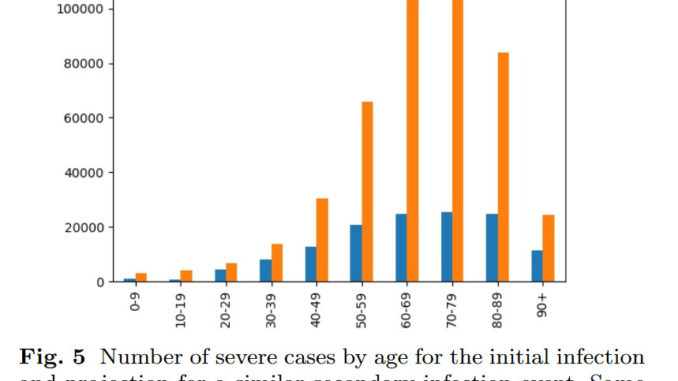
By Ian Wishart
One of the big unanswered questions about coronavirus is how big the second wave – if any – will be. Now, a new study puts forward a possible answer: three times worse than you think.
The interesting research comes out of France, where scientists believe the higher covid19 death rate in the over-60s is because they had survived exposure fifty years ago to the Hong Kong flu pandemic of 1968/69.
Those who have been paying attention to my reports will recall there’s already been research showing coronavirus may be using our immune systems to attack us, a process known as ‘Antibody Dependent Enhancement’.
The French team worked out that the last big flu pandemic ripped through the world in the late 1960s, and anyone born prior to 1968 may have developed antibodies to it.
They believe covid19 may have used those 1968 antibody responses in people to cause the cytokine storms that killed so many covid19 patients over 60.
They mapped the data and found the same generation of boomers and early Gen-Xers were hardest hit by the original SARS in 2003:
“The comparison of the 2003 and 2020 data..shows a striking difference between a panel of several European countries (France, Spain, Italy) with respect to the Hong Kong results. All curves share a common shape: a constant null range followed by a marked (exponential) increase starting in the ”30-39” age group for the 2003 data and ”50-59” group for all countries in 2020. This 20 years shift at the onset of the exponential regime can be interpreted as resulting from the existence of a common cause (situated approximately30-40 years before 2003 and 50-59 years before 2020,that is, between 1960 and 1970) that affected all people living at that date and which could explain why there are, 30 (respectively 50) years later, affected by the coronavirus outbreaks in a more severe way. Since the cause occurred before 1970 people born after this date will have no fragility, which is precisely what is seen in the plot.”
The interesting thing is this: People who were aged 50 back in 1968 would be 102 today, so clearly the current covid patients who developed antibodies to the HK flu in ’68 must for the most part have been young at the time. Like today’s asymptomatic coronavirus carriers, they may not even have realised they were exposed to the Hong Kong flu. Yet five decades later, another virus used those old antibodies to kill them. We’ll return to that five decade pattern shortly.
You will recall I have been warning that contrary to popular opinion, you don’t actually want to be exposed to covid19 even in a mild or asymptomatic form, because it means you will develop antibodies that the virus could use to bite you later..which is exactly what the French team is now warning:
“We interpret this as an evidence that previous infection history can negatively impact the individual outcome of a future infection. Note that historically the 1960-70 decade is rich in epidemic / virus related events: the Hong Kong flu of 1968-1969 (that killed an estimated 1 million people worldwide) but also the start of the identification of the four endemic human coronaviruses (mid-1960s). Note that such a conclusion is consistent with recent investigations, see [10] that showed that individuals are prone to repeated infection with coronaviruses, with the unfortunate consequence that not only the immunity may vanish (sometimes within a year) but that the re-infection can be more severe. Data displayed in the figure 2 substantiates the same conclusion.”
Just how severe? The new study estimates a genuine second wave (re-exposing people who’ve already had it) of covid19 globally, once 70% of the population have antibodies…could be up to three times deadlier than the lives lost in reaching the 70% spread (currently only 5-10% of the populations worst hit so far have been exposed, so there’s plenty more potential burn – multiply the current global death toll by seven to crudely guesstimate that 70% initial coverage).
In other words, the initial infection is only the first course…under this scenario the virus will serve up its main course down the track, triggering immune storms in people previously exposed or given vaccines. The study warns vaccine researchers to take the threat seriously.
 “if a sensitizing process in the immune response triggered by SARS-CoV-2 exists, the pandemic nature of the 2019/20 COVID-19 outbreak will likely have noticeable effects on the overall population health state. In particular, this implies that additional care has to be observed when validating vaccines against the COVID-19.
“if a sensitizing process in the immune response triggered by SARS-CoV-2 exists, the pandemic nature of the 2019/20 COVID-19 outbreak will likely have noticeable effects on the overall population health state. In particular, this implies that additional care has to be observed when validating vaccines against the COVID-19.
“The deterioration of the immune function can be evident on two occasions: either when a second epidemic occurs or when submitted to a challenge. The challenge can be very diverse, not necessarily in the form of a fully-fledged epidemic but also a small infection with an endemic coronavirus. This may manifest in the form of multi-organ inflammation.”
That’s pretty sobering. They suspect the antibodies created in the Hong Kong flu were a timebomb lying dormant in the over 50s that covid19 was able to exploit. And they suspect the global nature of this current pandemic, creating antibodies in children and everyone else it touches, could be this generation’s viral timebomb moving forward, with the added zing that a person carrying covid antibodies might even be triggered by something as insignificant as the common cold in the future.
Given that modern science has not had much direct real-time experience with coronavirus or big influenza pandemics, it may be that we are watching a longitudinal study play out before our eyes. It may be that this is the way viral contagions actually work.
Remember the five decade pattern I mentioned? HK flu in ’68 created antibodies in young people in the swinging sixties, most of whom brushed it off at the time. Their older parents and grandparents bore the brunt of the 68 flu, perhaps because their immune systems had in turn been pre-primed by exposure to the 1918 Spanish flu.
When you dig through the records you find these pandemics travel in waves. Before 1918, which was a new strain of flu virus, the previous big ‘flu’ epidemic had been 1889/1890, three decades earlier. That pandemic is now also believed to have been a novel coronavirus, not influenza. Before 1889, there had been a similar flu pandemic across the world in 1848/1849, infecting up to 50% of the population.
Each generation it seems, gets a major viral infection and develops antibodies. Those who survive recover and move on, but the viruses are playing a long game, and the antibodies they create become doorkeys opening our bodies up to the next big invader later in our lives.
In an NIH briefing on the 1918 pandemic, it notes that for reasons that doctors of that time couldn’t explain, the second season of a pandemic was always worse than the first:
“The experience with the 1889–1890 pandemic taught medical authorities that pandemic influenza was a disease of very high morbidity and low case fatality, although it seemed that in the outbreaks immediately following a pandemic, morbidity rates could be expected to decline and case fatality rates to rise.”
In New Zealand newspapers of 1918, the first wave of the Spanish flu was seen as a rather mild, ‘five day flu’ which, in rare cases extended into a second week and possibly death from pneumonia. The victims, as with most flu’s, were the elderly or unwell. But the 1919 reports were different. Young people were reported as getting first symptoms at 10am and being dead in their beds by 3pm. This wasn’t a ‘five day flu’. There were reports of supposedly healthy people dropping dead on the pavement. Autopsies revealed cytokine storms in the lungs, blood clots and ‘cerebral-spinal meningitis’ – massive inflammation of the central nervous system.
All of these things sound like covid19 at work in the elderly. They are also classic examples of antibody dependent enhancement (ADE), where the victim dies because their immune system antibodies betray them.
Will there be a second wave of covid19? New Zealand might dodge the bullet if its borders stay tight and tracing is gold standard, because so few kiwis were infected the first time around. As for the continents, the virus has spread too far. Let’s hope this latest research is wrong.
History, however, suggests it might be right.






